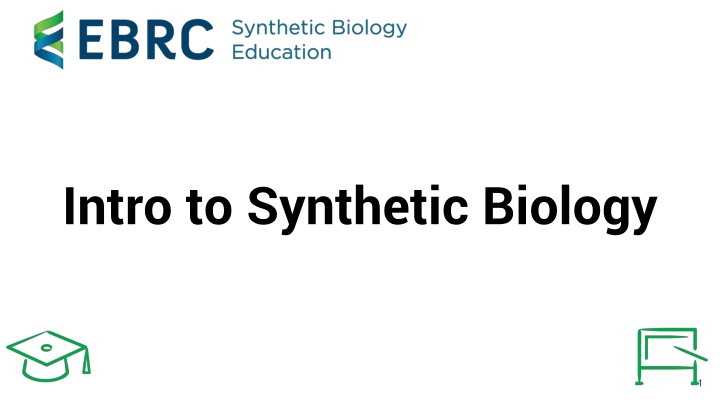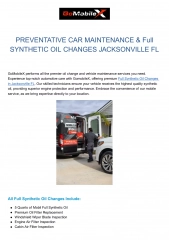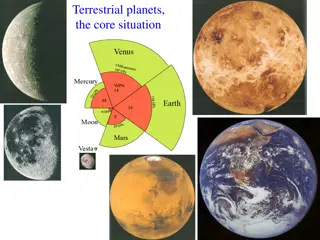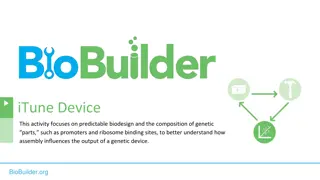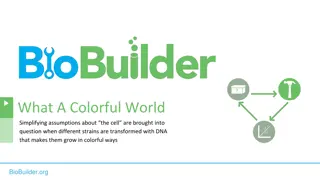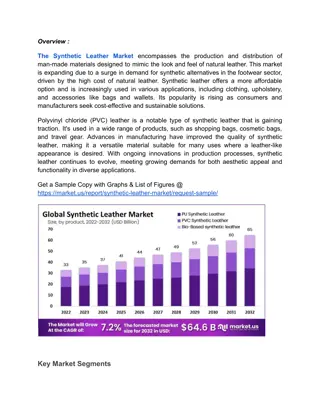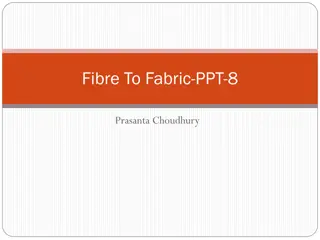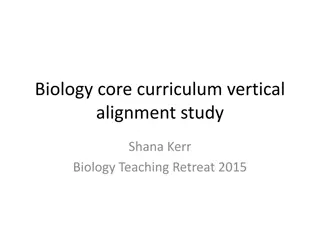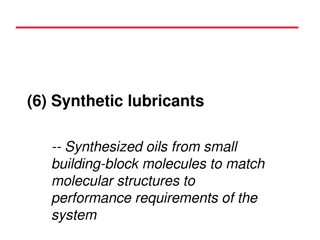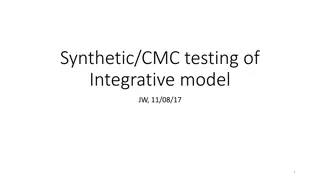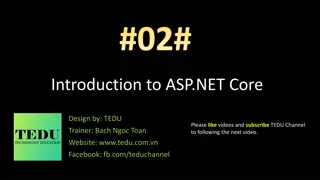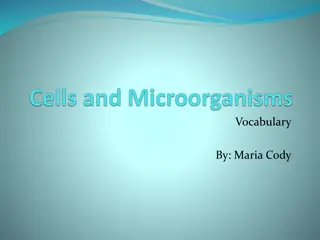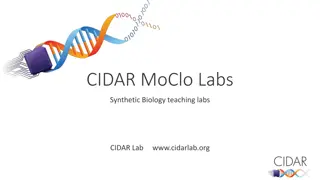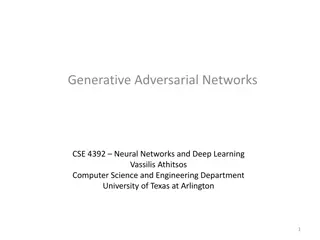Introduction to Synthetic Biology: Understanding the Core Concepts and Applications
In this introductory lecture on synthetic biology, you will explore the fundamental principles of engineering biology, including the design and construction of new biological entities. The focus is on leveraging molecular, cell, and systems biology advancements to create biological systems that can be modeled, understood, and tuned for specific purposes. By delving into the core tools of synthetic biology and its potential societal impacts, you will gain insights into planning design cycles, developing innovative ideas, and discovering diverse sectors where engineering biology can make a positive difference.
Download Presentation

Please find below an Image/Link to download the presentation.
The content on the website is provided AS IS for your information and personal use only. It may not be sold, licensed, or shared on other websites without obtaining consent from the author.If you encounter any issues during the download, it is possible that the publisher has removed the file from their server.
You are allowed to download the files provided on this website for personal or commercial use, subject to the condition that they are used lawfully. All files are the property of their respective owners.
The content on the website is provided AS IS for your information and personal use only. It may not be sold, licensed, or shared on other websites without obtaining consent from the author.
E N D
Presentation Transcript
Goals of this lecture You will be able to answer: What is synthetic biology? How can I Design, Build, Test, and Learn from biological systems? What are the Core Tools of synthetic biology? How and where can synthetic biology be applied to positively impact society? You will have: Planned a design cycle to approach a current problem Learned about engineering biology tools that can help you develop your idea Discovered the many sectors that engineering biology can positively impact Recommended knowledge: biology 101 level, generally how DNA & cells work 2
Table of Contents Concept 1-1: What is Synthetic Biology? Slides 4-23 -link Concept 1-2: Engineering Biology Roadmap & the DBTL Cycle Slides 24-28 -link Concept 1-3: Core Tools for Engineering Biology Part 1: Engineering DNA & Biomolecules Slides 29-48 -link Concept 1-4: Core Tools for Engineering Biology Part 2: Engineering Hosts and Data Science Slides 49-73 -link Concept 1-5: Impacts & Applications Slides 74-85 -link 3
Concept 1-1 What is Synthetic Biology? 4
What is Synthetic Biology? Engineering Biology (a broader term for Synthetic Biology) is the design and construction of new biological entities such as enzymes, genetic circuits, and cells or the redesign of existing biological systems. Engineering biology builds on the advances in molecular, cell, and systems biology and seeks to transform biology in the same way that synthesis transformed chemistry and integrated circuit design transformed computing. The element that distinguishes engineering biology from traditional molecular and cellular biology is the focus on the design and construction of core components (e.g., parts of enzymes, genetic circuits, metabolic pathways) that can be modeled, understood, and tuned to meet specific performance criteria, and the assembly of these smaller parts and devices into larger integrated systems to solve specific problems. Unlike many other areas of engineering, biology is incredibly non-linear and less predictable, and there is less knowledge of the parts and how they interact. Hence, the overwhelming physical details of natural biology (gene sequences, protein properties, biological systems) must be organized and recast via a set of design rules that hide information and manage complexity, thereby enabling the engineering of many-component integrated biological systems. It is only when this is accomplished that designs of significant scale will be possible. 5
What is Synthetic Biology? The goal: engineer living cells to do something useful; for example, treat a disease, sense a toxic compound in the environment, or produce a valuable drug. (BioBuilder) Engineering Biology Research Consortium (2019). Engineering Biology: A Research Roadmap for the Next-Generation Bioeconomy. Retrieved from http://roadmap.ebrc.org. doi: 10.25498/E4159B. 6
What is Synthetic Biology? Example: using industrial biotechnology to treat a disease Engineering Biology Research Consortium (2019). Engineering Biology: A Research Roadmap for the Next-Generation Bioeconomy. Retrieved from http://roadmap.ebrc.org. doi: 10.25498/E4159B. 7
Industrial: Bacterial production of insulin 8 Mona Dabbas & Javin Oza, California Polytechnic State University.
Industrial: Bacterial production of insulin What tools do we need? Insulin precursor genes Genetic parts for gene expression in E. coli Way to assemble these genetic parts The E. coli cells themselves Way to get the DNA into the cells Way to harvest insulin from bacteria Way to measure insulin production 9
Industrial: Bacterial production of insulin What steps do we need to take? Design a genetic circuit that will produce insulin in E. coli Build the genetic circuit, and put it into bacteria Test how much insulin is made Learn what did/didn t work, change design accordingly 10
Industrial: Bacterial production of insulin 11 NIH. From DNA to Beer: Harnessing Nature in Medicine & Industry. 2013.
Industrial: Bacterial production of insulin 12 NIH. From DNA to Beer: Harnessing Nature in Medicine & Industry. 2013.
Industrial: Bacterial production of insulin 13 NIH. From DNA to Beer: Harnessing Nature in Medicine & Industry. 2013.
Industrial: Bacterial production of insulin 14 NIH. From DNA to Beer: Harnessing Nature in Medicine & Industry. 2013.
What is Synthetic Biology? Example: use genetic circuits to mitigate an environmental pest Engineering Biology Research Consortium (2019). Engineering Biology: A Research Roadmap for the Next-Generation Bioeconomy. Retrieved from http://roadmap.ebrc.org. doi: 10.25498/E4159B. 15
Environment: Gene drives limit mosquito populations 16 Mona Dabbas & Javin Oza, California Polytechnic State University.
Environment: Gene drives limit mosquito populations 17 Marius Walter, Gene Drive.
Environment: Gene drives limit mosquito populations What tools do we need? Gene target to knock out or edit Genetic tool that will ensure these edits in all offspring Way to edit genes in mosquitoes Way to measure phenotypic changes from gene edits LOTS of safety testing strategies 18
Environment: Gene drives limit mosquito populations What steps do we take? Design a system that will knock out the selected gene in all offspring Build mosquitoes that carry this system Test the safety, efficacy, and spread of this gene system Learn by assessing how this impacts the mosquito population, overall environment, and disease spread 19
Environment: Gene drives limit mosquito populations 20 Marius Walter, Gene Drive.
Environment: Bioethics of gene drives Core Principles: 1. Use engineering biology to benefit the world 2. Weigh benefits of research against potential harms 3. Incorporate justice into all aspects of engineering biology 4. Share research 5. Protect the freedoms of individuals and researchers 6. Support open communication between researchers and other stakeholders Gene Drives: What are potential safety concerns of gene drives? Who should decide when and where gene drives are used? How can gene drives be contained, or undone after use? 21 Mackelprang, R., et al. (2021). Guiding ethical principles in engineering biology research.
Engineering biology as the next Kondratiev Wave 22 Michael Jewett, Northwestern University.
What is Synthetic Biology? Engineering Biology (aka Synthetic Biology) is the design and construction of new biological entities such as enzymes, genetic circuits, and cells or the redesign of existing biological systems. Engineering biology builds on the advances in molecular, cell, and systems biology and seeks to transform biology in the same way that synthesis transformed chemistry and integrated circuit design transformed computing. The element that distinguishes engineering biology from traditional molecular and cellular biology is the focus on the design and construction of core components (e.g., parts of enzymes, genetic circuits, metabolic pathways) that can be modeled, understood, and tuned to meet specific performance criteria, and the assembly of these smaller parts and devices into larger integrated systems to solve specific problems. Unlike many other areas of engineering, biology is incredibly non-linear and less predictable, and there is less knowledge of the parts and how they interact. Hence, the overwhelming physical details of natural biology (gene sequences, protein properties, biological systems) must be organized and recast via a set of design rules that hide information and manage complexity, thereby enabling the engineering of many-component integrated biological systems. It is only when this is accomplished that designs of significant scale will be possible. 23
Concept 1-2 Engineering Biology Roadmap & the DBTL Cycle 24
SynBio Roadmap From a Design, Build, Test, Learn centered approach Uses biological, engineering, and computational tools To positively impact multiple sectors Engineering Biology Research Consortium (2019). Engineering Biology: A Research Roadmap for the Next-Generation Bioeconomy. Retrieved from http://roadmap.ebrc.org. doi: 10.25498/E4159B. 25
The DBTL Cycle Design a biological circuit or system for a specific function using literature & computational tools. Build your system by assembling, editing, and installing genetic parts. Test system functionality using robust metrics & controls. Learn from how the system (doesn t) work to create new design rules, and share your knowledge. Gray, P. et al. Synthetic Biology in Australia: An Outlook to 2030 (Australian Council of Learned Academies, 2018). 26
DBTL: In Practice Design by finding genes for human insulin precursors, and optimize/model E. coli expression. Build gene sequence including insulin precursor genes though synthesis & assembly. Test your circuit in cells by measuring for insulin precursor proteins chemically via an assay. Learn how well your system works, and what optimization is necessary. Gray, P. et al. Synthetic Biology in Australia: An Outlook to 2030 (Australian Council of Learned Academies, 2018). 27
DBTL: Exercise 1. Choose a technology or problem that is impactful to you. 1. Think about what an engineering biology solution would look like: a. What would an initial design of the system look like? b. What tools and knowledge would you need to build this? c. How would you test whether your system worked? d. What might you learn about the problem through testing your solution? What might be issues when developing your system? e. And don t get too bogged down in the details! We ll go over more tools for each phase later. Example ideas: trees with fireproof wood, drought-resistant cabbage, sustainable bioplastics, engineered probiotics for gut health, cell-free water quality sensors 28
Core Tools Part 1: Engineering DNA, Biomolecular Engineering Concept 1-3 29
Core Tools for Engineering DNA What are the current tools for engineering DNA? Tools enabling a engineering DNA DBTL Synthesis Sequencing Standardization Assembly Editing Engineering Biology Research Consortium (2019). Engineering Biology: A Research Roadmap for the Next-Generation Bioeconomy. Retrieved from http://roadmap.ebrc.org. doi: 10.25498/E4159B. 30
Engineering DNA: Synthesis and Sequencing Gene synthesis and sequencing are becoming exponentially cheaper Entire genes can be synthesized in a matter of hours-days at relatively low cost This rapid reduction in cost and time for sequencing and synthesis allows large-scale testing of new genetic constructs 31 Carlson, R. Synthesis. On DNA and transistors.
Engineering DNA: How single-stranded DNA is synthesized Phosphoramidite chemical synthesis Pioneered by Marvin Caruthers in 1983 at CU-Boulder Single-stranded DNA oligos are synthesized using solid-phase chemistry performed on solid supports Controlled pore glass beads (IDT, GenScript) Silicon chip (Twist, Agilent) 32 Twist Bioscience. Twist Bioscience.
Engineering DNA: How double-stranded genes are synthesized Larger genes can be constructed using polymerase chain assembly of shorter synthetic fragments Short single-stranded oligos are stitched together and filled in using DNA polymerase and PCR to produce double-stranded genes 33 Dhorspool, PCA polymerase cycling assembly.
Engineering DNA: Standardized depiction of gene circuits Engineering Biology often requires descriptions of the DNA sequences used and how they function With the wealth of easy to synthesize DNA parts how do we communicate what pieces of synthetic DNA do? The Synthetic Biology Open Language (SBOL) is a framework for describing synthetic DNA sequences and their functional relationships 34
Engineering DNA: Examples of SBOL based diagrams On the left is a plasmid for chemically-inducible expression red fluorescent protein On the right is a plasmid for the light-inducible expression of the adhesins CdrAB Both of these plasmids express components that control the expression of other components The logical interpretations of the diagrams are listed below the image. 35
Engineering DNA: DNA assembly methods There are a range of techniques for assembling genetic parts into genetic constructs and plasmids in vitro Classical assembly (restriction enzyme + ligation) Golden gate assembly Gibson assembly 36
Engineering DNA: DNA assembly using Classical Assembly This approach has been used for vector cloning in molecular biology since the 1970s (Cohen SN, et al. PNAS (1973)70(11):3240-4) Type II restriction enzymes (RE) cut dsDNA typically within 6 bp palindromic sequences leaving 4 bp ssDNA overhangs Complementary overhangs can be ligated together using a DNA ligase This is also used in BioBrick cloning (EcoRI/XbaI, SpeI/PstI) Leaves behind RE site scars between DNA parts BioBrick Cloning using Classical Assembly 37
Engineering DNA: Multipart assembly using Golden Gate To overcome the limitation of scar sites and to improve ligation efficiency Golden Gate cloning was developed in 2008 (Engler C, et al., PLoS One (2008) 3(11):e3647) Type IIs restriction enzymes bind recognition sites, but cut outside of them This allows for the generation of programmable overhangs that eliminate scare sites between DNA parts and do not reform the original cut site improving efficiency 38
Engineering DNA: Multipart assembly using Golden Gate Golden Gate assembly can be easily achieved using PCR with primers that introduce Type IIs restriction sites (e.g., BsaI, BbsI, Esp3I) that flank parts Parts have unique complementary overhangs (OH1-4) that guide their assembly in the correct order This can be scaled to >50 fragments allowing for high-throughput multipart assembly 39
Engineering DNA: Multipart assembly using Gibson Assembly To facilitate large-scale DNA assembly in 2009 Gibson DNA assembly was developed (Gibson D.G., et al., Nat. Methods (2009) 6(5)343-345) This method utilizes in vitro homologous recombination facilitated by T5 exonuclease, Phusion polymerase, and Taq ligase This requires the introduction of ~40-60 bp of overlapping sequences (OS) on the ends of the sequences to guide DNA parts to assemble Has been scaled to assembly of entire genomes 40
Engineering DNA: High-throughput combinatorial DNA assembly The use of multi-part DNA assembly techniques enables the construction of large scale combinatorial libraries of DNA sequences This is useful when optimizing expression of multiple genes at once allowing for rapid exploration of parameter spaces This approach is often used for enhancing yield of metabolic pathways and engineering proteins 41
Engineering DNA: Editing Genomes by Knocking-IN or Knocking-OUT Genomes can also be engineered One strategy for genome editing is to leverage homologous recombination to delete genes (Knock-OUT) or to introduce entirely new sequences (Knock-IN) This can be achieved by introducing selective markers to select for cells within populations that have either gained (positive selection) or lost the engineered DNA (negative selection) 42
Engineering DNA: Using Recombineering to edit genomes Viral mechanisms for DNA integration have been co-opted to increase genomic engineering efficiency One approach, called recombineering , leverages the E. coli lambda prophage (Yu D, et al., PNAS (2000),97(11):5978-5983) Prophage proteins Exo, Beta, and Gam improve integration of DNA harboring genomic overlapping sequences by chewing back dsDNA to generate ssDNA, protecting ssDNA from degradation, and blocking host exonucleases, respectively 43
Engineering DNA: Using CRISPR-Cas9 to make precise genome edits Adaptive-immunity mechanisms from bacteria have been co-opted to enable precise genomic edits Clustered Regularly Interspaced Short Palindromic (CRISPR) systems from diverse bacteria have enabled a revolution in genomic editing Cas9 is one of the most widely used CRISPR systems used for genome engineering (Jinek M., et al., Science (2012) 337(6096):816-821) Cas9 is an RNA-guided endonuclease that makes double-stranded breaks at specific sites. Guide RNAs (gRNA) can be engineered target Cas9 to specific DNA sequences that precede PAM sites (NGG). One way to make genomic edits leverages homology directed repair to integrate an engineered repair template that eliminates the PAM site and subsequent retargeting. 44
Core Tools for Biomolecular Engineering What are our current tools for Biomolecular Engineering? Tools enable a Biomolecular Engineering DBTL Comprehensive Mutagenesis libraries Functional Screens Functional Selections Directed Evolution Engineering Biology Research Consortium (2019). Engineering Biology: A Research Roadmap for the Next-Generation Bioeconomy. Retrieved from http://roadmap.ebrc.org. doi: 10.25498/E4159B. 45
Biomolecular Engineering: Natural Macromolecules Natural macromolecules including proteins and RNAs can be engineered to have new properties (e.g., thermostability) or perform new functions (e.g., binding, catalysis) Directed evolution can be used to tailor the function of proteins through rounds of sequence diversification, selection for function, and amplification of 46 The Nobel Prize.
Biomolecular Engineering: Unnatural Macromolecules Entirely new protein sequences not seen in nature can be generated through de novo protein design De novo design enables exploration of protein sequence space beyond what nature has itself explored 47 Pan X. and Kortemme T. JBC Reviews (2021) 296 100558
Biomolecular Engineering: Circuits and Pathways In addition to individual biomolecules large scale networks of biomolecules Novel metabolic pathways can be constructed using retrosynthesis approaches Combinatorial libraries can be used to optimize expression of pathways proteins Adaptive laboratory evolution can be used to optimize the host genome for improved yield of a target molecule 48 Gurdo N., Volke D.C., Nikel P.I. (2022) Trends in Biotechnology
Core Tools Part 2: Host Engineering, Data Science Concept 1-4 49
Core Tools for Engineering Biology What types of hosts are there? Model & non-model systems Thinking across scales Engineering Biology Research Consortium (2019). Engineering Biology: A Research Roadmap for the Next-Generation Bioeconomy. Retrieved from http://roadmap.ebrc.org. doi: 10.25498/E4159B. 50
